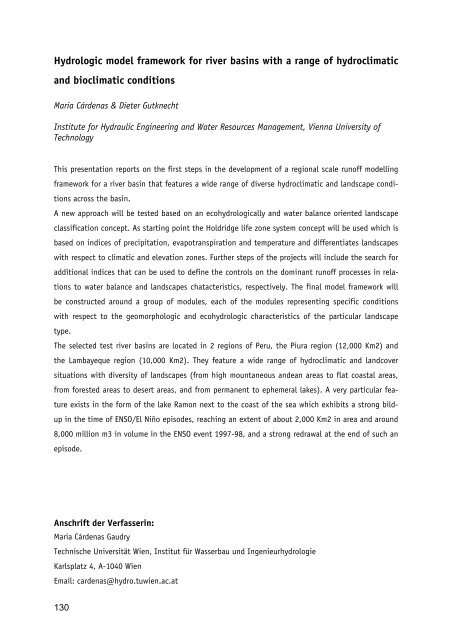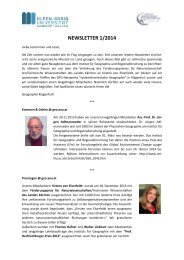Geographica Augustana - Institut für Geographie und ...
Geographica Augustana - Institut für Geographie und ...
Geographica Augustana - Institut für Geographie und ...
Sie wollen auch ein ePaper? Erhöhen Sie die Reichweite Ihrer Titel.
YUMPU macht aus Druck-PDFs automatisch weboptimierte ePaper, die Google liebt.
Hydrologic model framework for river basins with a range of hydroclimaticand bioclimatic conditionsMaria Cárdenas & Dieter Gutknecht<strong>Institut</strong>e for Hydraulic Engineering and Water Resources Management, Vienna University ofTechnologyThis presentation reports on the first steps in the development of a regional scale runoff modellingframework for a river basin that features a wide range of diverse hydroclimatic and landscape conditionsacross the basin.A new approach will be tested based on an ecohydrologically and water balance oriented landscapeclassification concept. As starting point the Holdridge life zone system concept will be used which isbased on indices of precipitation, evapotranspiration and temperature and differentiates landscapeswith respect to climatic and elevation zones. Further steps of the projects will include the search foradditional indices that can be used to define the controls on the dominant runoff processes in relationsto water balance and landscapes chatacteristics, respectively. The final model framework willbe constructed aro<strong>und</strong> a group of modules, each of the modules representing specific conditionswith respect to the geomorphologic and ecohydrologic characteristics of the particular landscapetype.The selected test river basins are located in 2 regions of Peru, the Piura region (12,000 Km2) andthe Lambayeque region (10,000 Km2). They feature a wide range of hydroclimatic and landcoversituations with diversity of landscapes (from high mountaneous andean areas to flat coastal areas,from forested areas to desert areas, and from permanent to ephemeral lakes). A very particular featureexists in the form of the lake Ramon next to the coast of the sea which exhibits a strong bildupin the time of ENSO/El Niño episodes, reaching an extent of about 2,000 Km2 in area and aro<strong>und</strong>8,000 million m3 in volume in the ENSO event 1997-98, and a strong redrawal at the end of such anepisode.Anschrift der Verfasserin:Maria Cárdenas GaudryTechnische Universität Wien, <strong>Institut</strong> <strong>für</strong> Wasserbau <strong>und</strong> IngenieurhydrologieKarlsplatz 4, A-1040 WienEmail: cardenas@hydro.tuwien.ac.at130



